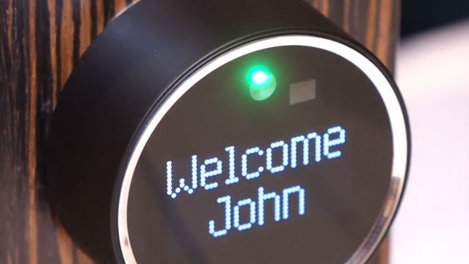Greetings from the present, Techies! We’ve time traveled here to Today from Yesterday, to tell you about all the new and exciting things that are coming Tomorrow, courtesy of CES 2014!
On this episode of Technically Speaking, Joe and Jacob report LIVE FROM CES… er, wait, no. It’s not actually live. And neither of them are actually at CES. But you get the point… Anyway, where was I?
Oh right! CES! And what was the buzz about during CES this year? Surprisingly, it wasn’t smartphones or televisions or laptops, but “The Connected Home“. We found a lot of great products that we loved that mixed home security and home automation in a way that traditional systems never did. Are consumers are going to be either elated and confused, as the myriad of products and protocols comes onto the market at near the same time? (We counted no less than 9 different wireless connectivity protocols on-site at CES. What is Qualcomm thinking?) What do you think? Are you interested in any of these devices, or do you think it’s just a gimmick? Let us know!
Next, we move onto a smarter way to build homes – and if you listen to our show regularly, you can probably already guess what we’re thinking – 3D Printing of course! Unfortunately, we don’t know enough about concrete to make a judgement on the longevity of this particular construction technique, but given the success and prevalence of traditional concrete homes, it’s likely that this type of structure will surprise us with it’s versatility. We like this particular system design, because it appears to easily scale-able. The scale model print-head is already functional, and scaling up simply requires employing traditional crane-and-gantry structures. Is this the future of home construction? We don’t really know, but we suspect it’s success will be highly dependent upon the quality of materials.
Finally, on the latest iteration of the Brainstorm, we respond to a post on the BrachioBoard forums about what factors affect fuel efficiency in cars. And woops! We got a little carried away! What is the bigger contributor to fuel consumption – weight, or aerodynamics? Why do Power and Fuel Consumption appear to be inversely proportional? And what technology will we see in the future that will improve fuel economy? Find out more when you listen!
We were really excited about this week’s topics, but we want to know what you think! Does a smart home intrigue you? So, thoughts? Let us know with an email, a comment on Facebook, a shout-out on Twitter, or a comment below! Or, if you like our answer, leave us a review on iTunes!
Run Time: 1:33:03
Music: “The House of the Rising Sun” – The Animals
Podcast: Play in new window | Download


You mention, briefly, in the part about 3d printing a house that the concrete might be more environmentally friendly than traditional lumber. I don’t know about that. Making cement is notoriously carbon intensive. About 900kg of CO2 release per tonne of cement produced according to wikipedia, much more so than for the wood from a well managed forest I would imagine.
Sure there’s more to environmental friendliness than just carbon emissions, but…
Making the cement/concrete might be carbon heavy up front, but making lumber isn’t carbon neutral either. Also, consider the the negative carbon impact of removing fully developed trees from the environment to build houses. The concrete house has a one-time hit to carbon emissions, while the wooden house has a negative impact annually until the replacement trees grow large enough to fully replace the capability of the originals.
Also, concrete homes are pretty good for insulation and energy usage. If your power comes from coal, as most does, the less energy your house uses the better.
I found this, but it is from a concrete house company. Take with as much salt as you feel necessary.
http://www.rastra.com/docs/sales/CO2_Impact_-_Wood_vs_Concrete.pdf
Dueling experts! There is a report by a group that does life cycle analyses of wood products (CORRIM, http://www.corrim.org/pubs/reports/2005/Phase1/index.asp) that came to the opposite conclusion. In this case it seems like forest management makes all the difference.
The point about insulation is a good one. Where I live (Edmonton, Alberta) concrete houses are basically unheard of, or at least nobody I work with knows anyone who has a concrete house. But people here are very cognisant of insulation and heat loss. If 3d printing can bring down the cost of a concrete house, and offer up better insulation, then the opportunities in places like here are pretty huge.
I’m surprised you guys got through the “Internet of Things” section without mentioning the recent story about how a hacked smart refrigerator was used to send malicious emails (http://www.proofpoint.com/about-us/press-releases/01162014.php).
You guys recently covered cyber security so maybe this doesn’t need a full section, but do you think security issues could slow or halt the adoption of “Internet of Things” devices?
Great show, keep up the good work.
I predict that security will continue to be an afterthought in all things.
Re the keyless entry systems that sense a keyfob or a smartphone: what’s their failure mode in the event of a power loss? If there’s no physical-key override, then you get locked out of your house in a blizzard that knocks out your electricity. If there’s an alternate entry with a key, then this doesn’t give you any added security.